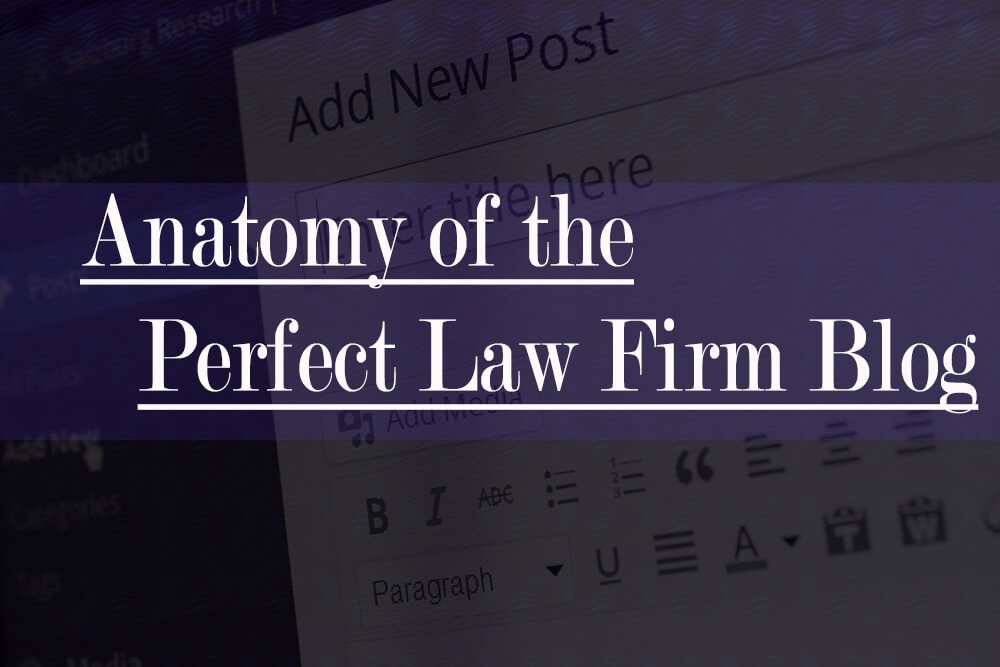Anatomy of the Perfect Law Firm Blog – Part 1: Introduction
Today we’re starting a brand new series that looks at each of the individual parts that make up the perfect law firm blog. Every marketing website on the planet has about 50+ generalized, fluffy articles on how to write a generalized, fluffy blog, but you want more than generalized fluff, right?
We’re here to rise above the fluff (I’d say “noise”, but you and I both know fluff isn’t very loud–nor noticeable!). We’re here to help lawyers and law firms create stellar legal blogs by breaking down each essential component.
Ready to dive in? Let’s start.
Part 1: Introducing the Introduction
What’s the first step of writing a good introduction? Hook the reader with an interesting first sentence. Relate it to your main topic. Now present a question that your reader may have so they’ll continue to read for the answer. That’s the goal.
It’s a daunting task each time—how should you begin a blog in a way that engages the reader and holds their attention for the next 600 words? How could anyone do this, especially in the age of Twitter?
You don’t have to swap word count with character limit just yet.
There are a few rules to keep in mind when you’re writing an introduction. If your blog follows these baselines and avoids common techniques that prevent your blog from standing out, you’ll be writing unique introductions that invite and captivate your reader.
What Strengthens Your Introduction?
If you want to bring your reader in but also keep their attention, asking questions about your topic can do the trick. Phrasing questions with “Have you” or beginning them with “How” can produce a question that relates to the reader. For example: “Have you ever had issues starting your blog?” and “How are you supposed to start an interesting blog?”
You may have noticed those questions use “you.” Writing a blog for the internet differs from a scholarly essay. You don’t want your blog to sound detached or too rigid. Using “you” in your blog makes it sound direct, personable, and casual. You have an opportunity to have a conversation with your reader instead of talking at them.
Keep your introduction concise. A great fool once said, “Brevity is the soul of wit,” which is important to consider, but also don’t take it as blog gospel because that character is later stabbed through a curtain.
While you don’t want to bog down your introduction with fluff and risk losing your reader from the start, rushing head-first into your topic won’t do you any favors, either. But you can find a balance between a dense block of text and a one sentence introduction that leaves out vital information.
Try keeping your introduction between 3-5 sentences. People typically scan the page before reading. Shorter paragraphs will be easier to read and are less of a strain on your reader’s eyes. That’s plenty of room to catch your reader’s attention, introduce the topic or issue, and transition to the next section of your blog.
What Should You Avoid?
Watch out that your blog doesn’t fall into any writing traps because they make your blog sound tedious, unprofessional, and less urgent. It also takes away your chance to write in a clear voice that stands out above the rest.
Clichés are vague and boring to read. They’re also easy to write because you’ve read them and heard them already. If you find places where you’ve written a cliché, turn this into an opportunity to get specific. Figure out exactly what you want to say in this sentence and write it.
Poor grammar has no place in a blog. While you’re still aiming for casual, remember you’re writing professionally. Abandoning every grammar lesson you’ve ever had undermines your intelligence and your credibility. Compare “You’re gonna wanna write like this for your blog,” and “You’re going to want to write like this for your blog.” Striking, isn’t it?
Don’t bury your lede. The term “lede” is more common in newswriting, but it applies in blogs as well. The phrase stresses that you should start your piece with pertinent facts instead of beginning with something general or unimportant and getting to the meaningful points later. In your 3-5 sentence introduction, present your main point by the second or third sentence.
At Legal InSites, we understand the value of producing engaging and unique content that stands out to your readers. High quality content helps your business rank and possibly bring in more clients. Have any questions about the points above? We can help. Get in touch with us today.
Come see us at these events.

WAJ Winter Seminar & Annual Meeting 2024
GAVL is attending the 2024 Wisconsin Association for Justice Winter Seminar & Annual Meeting!

CAOC Annual Convention 2024
GAVL will be a sponsor and attending the 2024 Consumer Attorneys of California Annual Convention!

OAJ 2024 Winter Convention
GAVL is excited to attend and exhibit at the Ohio Association for Justice 2024 Winter Convention!


